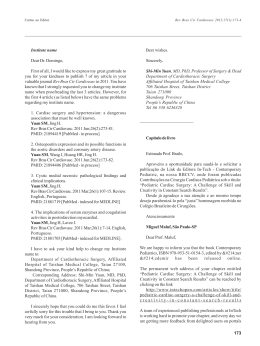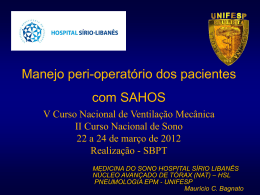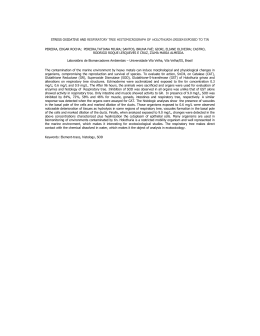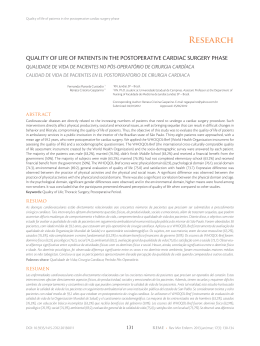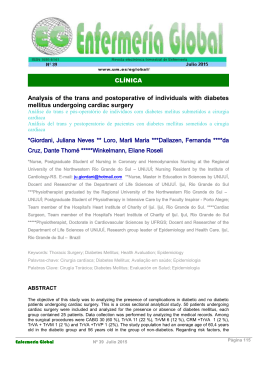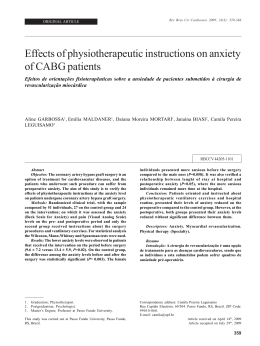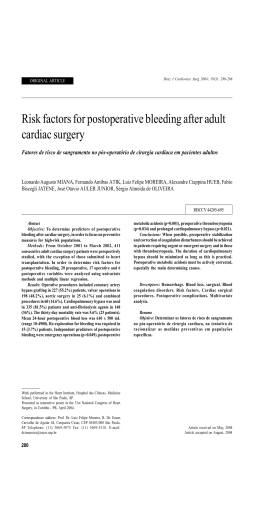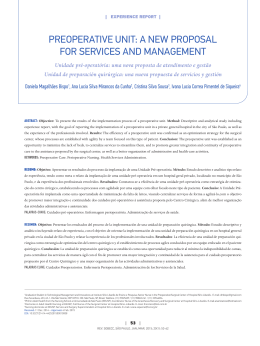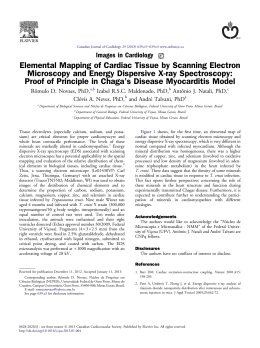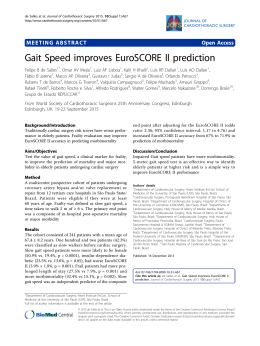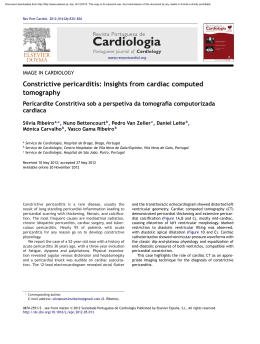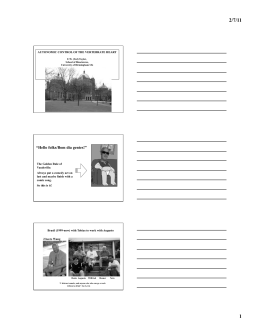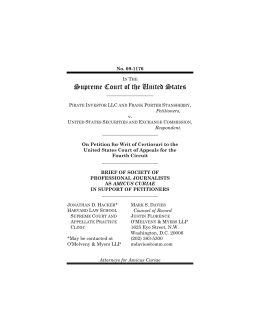REVIEW ARTICLE Rev Bras Cir Cardiovasc 2011;26(4):647-52 Respiratory physiotherapy and its application in preoperative period of cardiac surgery Fisioterapia respiratória e sua aplicabilidade no período pré-operatório de cirurgia cardíaca Regina Coeli Vasques de Miranda1, Susimary Aparecida Trevizan Padulla1, Carolina Rodrigues Bortolatto2 DOI: 10.5935/1678-9741.20110057 RBCCV 44205-1333 Resumo Procedimentos cirúrgicos torácicos podem alterar a mecânica respiratória, repercutindo na função pulmonar. A presença de profissionais fisioterapeutas é fundamental no preparo e na reabilitação dos indivíduos que são submetidos à cirurgia cardíaca, visto que dispõem de um grande arsenal de técnicas. O objetivo foi verificar a efetividade de exercícios respiratórios, com e sem a utilização de dispositivos, e o treinamento muscular respiratório pré-cirurgia cardíaca na redução das complicações pulmonares pós-operatórias. Mesmo existindo controvérsias a respeito de qual técnica utilizar, estudos demonstram a eficácia da fisioterapia respiratória pré-cirúrgica na prevenção e na redução de complicações pulmonares pós-operatórias. Abstract Cardiac surgical procedures change respiratory mechanics, defecting in lung dysfunction. The physical therapists play an important role in the preparation and rehabilitation of individuals who are undergoing cardiac surgery, as they have a large quantity of techniques. The objective was to evaluate the effectiveness of breathing exercises with and without the use of devices, and respiratory muscle training in preoperative period of cardiac surgery in reducing postoperative pulmonary complications. Although there are controversies as to which technique to use, studies show the effectiveness of preoperative physiotherapy in the prevention and reduction of postoperative pulmonary complications. Descritores: Procedimentos cirúrgicos cardíacos. Modalidades de fisioterapia. Reabilitação. Complicações pósoperatórias. Descriptors: Cardiac surgical procedures. Physical therapy modalities. Rehabilitation. Postoperative complications. 1. PhD; Assistant Professor at Faculty of Sciences and Technology at State University of São Paulo (UNESP) Júlio de Mesquita Filho – Campus Presidente Prudente, Presidente Prudente, SP, Brazil. 2. Graduation in Physiotherapy; Student Specialist in Hospital Physiotherapy at Faculty of Sciences and Technology at State University of São Paulo (UNESP) Júlio de Mesquita Filho – Campus Presidente Prudente, Presidente Prudente, SP, Brazil. Correspondence address: Regina Coeli Vasques de Miranda. Rua Roberto Simonsen, 305 – Jardim das Rosas – Presidente Prudente, SP, Brazil Zip Code: 19060-900 E-mail: [email protected] This study was carried out at Faculty of Sciences and Technology at State University of São Paulo (UNESP) Júlio de Mesquita Filho – Campus Presidente Prudente, Presidente Prudente, SP, Brazil. Article received on April 5th, 2011 Article accepted on August 29th, 2011 647 Miranda RCV, et al. - Respiratory physiotherapy and its application in preoperative period of cardiac surgery INTRODUCTION An important moment in the history of medicine of the twentieth century was the performance of the open surgical technique, allowing constant technical advances, including relevant national contributions [1]. Following the path of conquest, surgical treatment remains the best therapeutic modality related to survival of individuals with coronary heart disease, as well as in individuals with valvular dysfunction [1,2]. Despite numerous advances, the occurrence of complications after cardiac interventions is very common and is a major cause of postoperative morbidity and mortality [2,3]. Historically, respiratory physiotherapy has been used in patients undergoing cardiac surgery in order to reduce the risk of pulmonary complications, such as retention of secretions, atelectasis and pneumonia [4], both in adults and in children [5]. Participation in the preparation of physiotherapists and rehabilitation of individuals who are undergoing surgical procedures are relevant, given the great arsenal of techniques available [6]. It is described in the literature, in addition to the relative scarcity, that studies related to the approach of physiotherapy in the preoperative have different techniques [7]. Given the importance of physiotherapy in the prevention and treatment of postoperative complications, this literature review was written, in order to gather relevant information on this subject. REVIEW Leguisamo et al. [8] recommended that physiotherapy should be started preoperatively, to assess and educate patients. Studies have shown that preoperative physiotherapeutic significantly reduced the risk of developing pulmonary complications after the surgery of children under the age of six years [9]. Garbossa et al. [6] suggest that the time spent is better spent, and the professional can answer questions of the individual and guide him as to new situations that will face. The importance of proper preoperative assessment in cardiac patients is due to the fact that it is common the reduced lung volumes postoperatively. The decrease in functional residual capacity (FRC) is one of the key determinants of hypoxemia and atelectasis, which can occur in this type of surgery [10]. Surveys performed in Australia and New Zealand by Reeve et al. [11] and in Sweden by Westerdahl & Möller [12] found that the majority of physiotherapists provides preoperative information for patients undergoing elective cardiac surgery, such as early mobilization, sternotomy restrictions, risk of pulmonary complications techniques 648 Rev Bras Cir Cardiovasc 2011;26(4):647-52 for getting in and out of bed/chair, breathing exercises, cough techniques and information on exercise lower limb. Thus, the guidance given to patients regarding their responsibilities in relation to treatment, helps their direct participation during the postoperative period [8,12,13]. Studies on post-surgical changes show that lung volume does not depend solely on the activity of respiratory muscles, but also the mechanical properties of the lungs. The reduction in lung compliance, increased airway resistance and the abolition of sighs are also factors observed after cardiac surgery. The lower diaphragmatic mobility implies the pain associated with reduced FRC, reducing ventilation and expandability of the lower areas of the lungs [10]. Giacomazzi et al. [14] demonstrated in their studies that the pain was the most persistent complaints, as well as significant reduction in lung function until the fifth postoperative day. Several protocols of preoperative pulmonary assessment were established over the years. Some studies confirm the relevance of the history of the patient, the presence of chronic obstructive pulmonary disease, smoking, obesity and age [2,7-10,15,16]. They used spirometry to determine the values of forced vital capacity and forced expiratory volume in one second, measurement of maximum inspiratory and expiratory pressures by manometer and cirtometry for obtaining measurements of the circumferences and thoracoabdominal motion [2,7,10,14-16]. The chest radiograph, taken to be a useful, minimally invasive, low cost, although rarely requested preoperatively, became routine in the postoperative period [17]. Due to the increasing costs of health services and more options for the treatment of heart diseases, the identification of patient risk factors for postoperative complications may influence the decision about the appropriate course of action. Similarly, funding organizations of procedures need to define the complications of risk parameters to improve resource planning and the final cost of hospitalization [18]. It is important therefore to identify the preoperative period, patients with higher risk of postoperative complications, because it is high the number of variables that can interfere with a surgical procedure [19]. Several scales and scores can be used in the evaluation processes involved in cardiorrhespiratory rehabilitation in cardiac surgery. The Torrington and Henderson Scale, useful in the preoperative clinical evaluation of surgical patients can adequately stratify the risk of low, moderate and high intensity for the occurrence of pulmonary complications and death due to pulmonary elective general surgery. This stratification ensures that specific strategies and preventive measures are dispensed to patients at higher risk [20]. Miranda RCV, et al. - Respiratory physiotherapy and its application in preoperative period of cardiac surgery Rev Bras Cir Cardiovasc 2011;26(4):647-52 The heart rate variability has also emerged as a simple noninvasive measure in the evaluation of autonomic nervous system, a regulator of physiological processes in the human body and indicator of health commitment [21]. The Tuman score identifies the group of patients with increased risk of infectious complications, as the infection remains a major cause of morbidity and mortality in surgical patients, with a special interest in identifying risk factors for its occurrence [18] . Prolonged hospitalization of patients awaiting coronary artery bypass surgery presents potential risk of immobilization [22]. Taking into account the presentation of pulmonary dysfunction associated with cardiac surgery and its possible repercussions, respiratory physiotherapy has been requested in order to reverse or prevent the development of pulmonary complications [4.23], using variety of techniques. However, a systematic review of the literature shows that there are controversies on the subject, making it difficult to decide which resource would be more useful and less expensive in the management of these patients. The techniques used in respiratory physiotherapy vary according to countries and with the practice of each service [18]. The ventilatory exercises consists in the adjustment of inspiratory and expiratory ventilation depth to the more appropriate pattern of ventilatory muscle, both in terms of respiratory rate and tidal volume. Physiotherapy guides the patient to properly use the ventilatory muscle and understand the different types of ventilatory patterns, through practical demonstration of this process [3,24,25]. An observational study performed in Spain with 263 patients, of whom 159 received preoperative physiotherapy showed that incentive spirometry, deep breathing exercises, early ambulation and assisted cough are related to lower incidence of atelectasis (17% vs. 36 %) after CABG with CPB, the difference being considered significant and clinically relevant [26]. In 2005, Westerdahl et al. [23] concluded that preoperative physiotherapy, with deep breathing exercises when compared to the system without breathing instructions significantly decreased atelectasis and improved ventilation spirometry. Physiotherapy treatment of difficult resolution of atelectasis during pediatric cardiac surgery had better mucociliary clearance after inhalation of hypertonic saline with 6% NaCl [27]. Leguisamo et al. [8] studied the effectiveness of a physiotherapy program of breathing patterns in the preoperative coronary artery bypass grafting. They concluded that patients educated preoperatively will be better prepared to collaborate with the postoperative treatment and understanding of the aims of pre- and postoperative physiotherapy and the proposed technique can reduce the length of stay in hospital. Comparative data between groups of children who received pre- and postoperative physiotherapy and group that performed exercises only in the postoperative period showed that pulmonary complications were significantly lower in the group that underwent physiotherapy before and after surgery [9]. Studies by Garbossa et al. [6] found that individuals instructed and advised to exercise ventilatory physiotherapy (ventilatory pattern as 1:1, 2:1 and 3:1) and hospital routines in the preoperative period showed lower levels of anxiety compared to individuals who had not received guidance . A pre- and postoperative cardiopulmonary rehabilitation program performed on patients who are awaiting surgery in hospital, showed superior results to standard treatment, reducing postoperative complications and length of hospital stay [22]. In contrast, Brasher et al. [4] concluded that the removal of breathing exercises from routine physiotherapy did not alter significantly the result of the patient. Similarly, Pasquina et al. [28] in a review concluded that there is insufficient evidence about the benefits of any type of prophylactic respiratory therapy after cardiac surgery, and that is broader than has been justified by the results of clinical research. In patients undergoing elective cardiac surgery, BorghiSilva et al. [29] demonstrated a high prevalence of spirometric changes in the preoperative and justified the importance of early physiotherapy intervention in reducing the incidence of respiratory complications after the surgery. Similarly, Westerdahl et al. [23] recognized that a mechanical device could help patients to remember to do breathing exercises, and that they found these devices useful and motivating. The literature suggests that several treatments commonly used by physiotherapists in the postoperative period, including incentive spirometry (IS) may be adequate in meeting the physiological demands of lung re-expansion [30]. The use of IS is performed through slow and deep inspiration from FRC to total lung capacity, followed by sustained inspiration. The use of the device provides a visual feedback to patients, generating better gas flow to the alveoli and increased lung expansion [31]. Thus, it is justified the preemptive use of IS in the period before the procedure, since the individuals presented breathing disorders after surgery. Some studies have shown that the spirometer volume (SV) develop lower respiratory activity when compared to the spirometer flow (SF). Other authors found that during the use of SV, there is greater mobility of the abdominal cavity, the lower recruitment of accessory muscles of respiration and increased tidal volume when compared to the use of SF [32,33]. Renault et al. [34] aimed to identify the effect of deep breathing exercises (DBE) and SF in patients undergoing 649 Miranda RCV, et al. - Respiratory physiotherapy and its application in preoperative period of cardiac surgery Rev Bras Cir Cardiovasc 2011;26(4):647-52 coronary artery bypass grafting and found no significant differences in maximal respiratory pressures, spirometric variables and oxygen saturation in patients in the different techniques used. Tomich et al. [33] compared three breathing exercises: diaphragmatic breathing, SF (Trifle II) and SV (Voldyne). They found that the difference between breathing and diaphragmatic Voldyne was a significant increase in the inspiratory cycle compared to baseline. The Trifle II was associated with increased respiratory rate and electromyographic activity of the sternocleidomastoid muscle, and concluded that diaphragmatic breathing and Voldyne showed similar results, while Trifle II showed disadvantages compared to others. Similarly, results of the Yamaguti et al. [35] suggested that the use of SV and diaphragm exercises seem to be equally effective in the treatment of respiratory disorders, whose therapeutic aim is the development of diaphragmatic motion. This study noted that it is considered an indication of the careful and appropriate type of incentive spirometer to be used in clinical practice. Finally, they found that women presented better performance in all breathing exercises when compared to men. Agostini et al. [36] concluded that physiotherapy, with or without incentive spirometry reduces the incidence of postoperative complications and improves lung function. However, there is currently no evidence that the use of non-oriented incentive spirometry could replace or significantly increase the work of physiotherapists. It is known that a dysfunction of respiratory muscles due to surgery may lead to a reduction in vital capacity, tidal volume, total lung capacity and consequent failure of the cough. These low values can cause atelectasis, a risk factor for lung infections, and decreased functional residual capacity, which, in turn, alters the properties of exchange and increased ventilation/perfusion. Some researchers indicate - in order to prevent postoperative atelectasis - the maintenance of adequate respiratory muscle strength [37]. According Saglam et al. [38], adequate muscle strength preoperatively of thoracic surgery is responsible for increased functional capacity when compared to subjects who had muscle weakness in the period prior to surgery. The respiratory muscle weakness preoperatively increases the risk of pulmonary complications in the postoperative period and inspiratory muscle training (IMT) can help prevent complications in the postoperative period [33,34]. A study using IMT of linear load based on 30% of PImax, with a gradual increase in the preoperative period presented reduced pulmonary complications in 50% when compared to studies with patients who underwent physiotherapy without inspiratory muscle training. And therefore, the duration of postoperative hospitalization was significantly lower [39]. The conclusion to this finding, according Feltrim et al. [40], was that IMT has avoided major pulmonary complications because improved strength and endurance of respiratory muscles, but was unable to prevent those of minor grade, whose pathophysiology may be associated with effects but respiratory muscle dysfunction. Thus, the benefit obtained by the reduction of pulmonary complications of greater impact supports the indication of IMT in the preoperative elective surgery of coronary artery bypass grafting in patients at high risk. There is the possibility of residential programs for inspiratory muscle training, according the study by Ferreira et al. [41], which proved to be safe and resulted in improvement in forced vital capacity and maximum voluntary ventilation, although its clinical benefits are not evident. 650 FINAL CONSIDERATIONS The analysis of these studies revealed that the patient care in the preoperative period, information on post-surgical restrictions, technics of bed/chair transfer, and the importance of breathing and physical exercises accelerate the process of postoperative recovery. As noted, many patients have basal respiratory disorders, which, coupled with anxiety and pain due to surgery, induce changes in respiratory rhythm and pattern. In addition to post-surgical restrictions, the ineffectiveness of the cough has negative influence on the patient’s respiratory status. However, in clinical practice there are controversies about the techniques, making it difficult to decide which resource would be more useful and less expensive in the management of these patients. Several studies have demonstrated the effectiveness of breathing exercises with and without the use of devices, when compared to the groups who did not perform exercise. With regard to respiratory physiotherapy, increasingly required, it is up to the professional to verify the patient’s need and the availability of resources and devices, considering the individuality of each patient to perform breathing exercises, as noted, different techniques have similar results. REFERENCES 1. Braile DM, Godoy MF. História da cirurgia cardíaca. Arq Bras Cardiol. 1996;6(1):329-37. Miranda RCV, et al. - Respiratory physiotherapy and its application in preoperative period of cardiac surgery Rev Bras Cir Cardiovasc 2011;26(4):647-52= 2. Beluda FA, Bernasconi R. Relação entre força muscular respiratória e circulação extracorpórea com complicações pulmonares no pós-operatório de cirurgia cardíaca. Rev Soc Cardiol Estado de São Paulo. 2004;14(5Suppl A):1-9. 14. Giacomazzi CM, Lagni VB, Monteiro MB. A dor pósoperatória como contribuinte do prejuízo na função pulmonar em pacientes submetidos à cirurgia cardíaca. Rev Bras Cir Cardiovasc. 2006;21(4):386-92. 3. Renault JA, Costa-Val R, Rossetti MB, Houri Neto M. Comparison between deep breathing exercises and incentive spirometry after CABG surgery. Rev Bras Cir Cardiovasc. 2009;24(2):165-72. 15. Guizilini S, Gomes WJ, Faresin SM, Bolzan DW, Alves FA, Catani R, et al. Avaliação da função pulmonar em pacientes submetidos à cirurgia de revascularização do miocárdio com e sem circulação extracorpórea. Rev Bras Cir Cardiovasc. 2005;20(3):310-6. 4. Brasher PA, McClelland KH, Denehy L, Story I. Does removal of deep breathing exercises from a physiotherapy program including pre-operative education and early mobilization after cardiac surgery alter patient outcomes? Aust J Physiother. 2003;49(3):165-73. 5. Cavenaghi S, Moura SC, Silva TH, Venturinelli TD, Marino LH, Lamare NM. Importance of pre- and postoperative physiotherapy in pediatric cardiac surgery. Rev Bras Cir Cardiovasc. 2009;24(3):397-400. 6. Garbossa A, Maldaner E, Mortari DM, Biasi J, Leguisamo CP. Efeitos de orientações fisioterapêuticas sobre a ansiedade de pacientes submetidos à cirurgia de revascularização miocárdica. Rev Bras Cir Cardiovasc. 2009;24(3):359-66. 7. Arcêncio L, Souza MD, Bortolin BS, Fernandes AC, Rodrigues AJ, Évora PR. Pre-and postoperative care in cardiothoracic surgery: a physiotherapeutic approach. Rev Bras Cir Cardiovasc. 2008;23(3):400-10. 16. Baumgarten MCS, Garcia GK, Frantzeski MH, Giacomazzi CM, Lagni VB, Dias AS, et al. Comportamento da dor e da função pulmonar em pacientes submetidos à cirurgia cardíaca via esternotomia. Rev Bras Cir Cardiovasc. 2009;24(4):497-505. 17. Morsch KT, Leguisamo CP, Camargo MD, Coronel CC, Mattos W, Ortiz LDN et al. Perfil ventilatório dos pacientes submetidos a cirurgia de revascularização do miocárdio. Rev Bras Cir Cardiovasc. 2009;24(2):180-7. 18. Strabelli TMV, Stolf NAG, Uip DE. Uso prático de um índice de risco de complicações após cirurgia cardíaca. Arq Bras Cardiol. 2008;91(5):342-7. 19. Nina RVAH, Gama MEA, Santos AM, Nina VJS, Figueiredo Neto JA, Mendes VGG, et al. O escore de risco ajustado para cirurgia em cardiopatias congênitas (RACHS-1) pode ser aplicado em nosso meio? Rev Bras Cir Cardiovasc. 2007;22(4):425-31. 8. Leguisamo CP, Kalil RAK, Furlani AP. A efetividade de uma proposta fisioterapêutica pré-operatória para cirurgia de revascularização do miocárdio. Rev Bras Cir Cardiovasc. 2005;20(2):134-41. 20. Faresin SM, Barros JA, Beppu OS, Peres CA, Atallah NA. Aplicabilidade da escala de Torrington e Henderson. Rev Assoc Med Bras. 2000;46(2):159-65. 9. Felcar JM, Guitti JCS, Marson AC, Cardoso JR. Preoperative physiotherapy in prevention of pulmonary complications in pediatric cardiac surgery. Rev Bras Cir Cardiovasc. 2008;23(3):383-8. 21. Vanderlei LCM, Pastre CM, Hoshi RA, Carvalho TD, Godoy MF. Basic notions of heart rate variability and its clinical applicability. Rev Bras Cir Cardiovasc. 2009;24(2):205-17. 10. Cavalheiro LV, Chievegato LD. Avaliação pré-operatória do paciente cardiopata. In: Regenga MM, ed. Fisioterapia em cardiologia da UTI à reabilitação. São Paulo:Rocca;2000. 22. Herdy AH, Marcchi PL, Vila A, Tavares C, Collaço J, Niebauer J, et al. Pre- and postoperative cardiopulmonary rehabilitation in hospitalized patients undergoing coronary artery bypass surgery: a randomized controlled trial. Am J Phys Med Rehabil. 2008;87(9):714-9. 11. Reeve J, Denehy L, Stiller K. The physiotherapy management of patients undergoing thoracic surgery: a survey of current practice in Australia and New Zealand. Physiother Res Int. 2007;12(2):59-71. 12. Westerdahl E, Möller M. Physiotherapy-supervised mobilization and exercise following cardiac surgery: a national questionnaire survey in Sweden. J Cardiothorac Surg. 2010;5:67. 13. Bethune DD, Potter HM, McKenzie D. Técnicas fisioterápicas. In: Pryor JA, Webber BA, eds. Fisioterapia para problemas respiratórios e cardíacos. 2ª ed. Rio de Janeiro:Guanabara Koogan;2002. p.97-150. 23. Westerdahl E, Lindmark B, Eriksson T, Friberg O, Hedenstierna G, Tenling A. Deep-breathing exercises reduce atelectasis and improve pulmonary function after coronary artery bypass surgery. Chest. 2005;128(5):3482-8. 24. Renault JA, Costa-Val R, Rossetti MB. Respiratory physiotherapy in the pulmonary dysfunction after cardiac surgery. Rev Bras Cir Cardiovasc. 2008;23(4):562-9. 25. Sciaky AJ. Educação do paciente. In: Frownfelter D, Dean E, eds. Fisioterapia cardiopulmonar: princípios e prática. 3ª ed. Rio de Janeiro:Revinter;2004. 651 Miranda RCV, et al. - Respiratory physiotherapy and its application in preoperative period of cardiac surgery Rev Bras Cir Cardiovasc 2011;26(4):647-52 26. Yánez-Brage I, Pita-Fernández S, Juffé-Stein A, MartínezGonzález U, Pértega-Díaz S, Mauleón-García A. Respiratory physiotherapy and incidence of pulmonary complications in off-pump coronary artery bypass graft surgery: an observational follow-up study. BMC Pulm Med. 2009;9:36. 34. Renault JA, Costa-Val R, Rossetti MB, Houri Neto M. Comparação entre exercícios de respiração profunda e espirometria de incentivo no pós-operatório de cirurgia de revascularização do miocárdio. Rev Bras Cir Cardiovasc. 2009;24(2):165-72. 27. Silva NLS, Poitto RF, Barboza MAI, Croti UA, Braile DM. Inalação de solução salina hipertônica como coadjuvante da fisioterapia respiratória para reversão de atelectasia no pósoperatório de cirurgia cardíaca pediátrica. Rev Bras Cir Cardiovasc. 2006;21(4):468-71. 28. Pasquina P, Tramèr MR, Walder B. Prophylactic respiratory physiotherapy after cardiac surgery: systematic review. BMJ. 2003;327(7428):1379. 29. Borghi-Silva A, Di Lorenzo PVA, Oliveira CR, Luzzi S. Comportamento da função pulmonar e da força da musculatura respiratória em pacientes submetido à revascularização do miocárdio e a intervenção fisioterapêutica. Rev Bras Ter Intensiva. 2004;16(3):155-9. 30. Agostini P, Singh S. Incentive spirometry following thoracic surgery: what should we be doing? Physiotherapy. 2009;95(2):76-82. 31. Wilkins RL, Scanlan CL. Terapias de expansão pulmonar. In: Scanlan CL, Wilkins RL, Stoller JK, eds. Fundamentos da terapia respiratória de Egan. São Paulo:Manole;2000. p.797843. 32. Parreira VF, Tomich GM, Britto RR, Sampaio RF. Assessment of tidal volume and thoracoabdominal motion using volume and flow-oriented incentive spirometers in healthy subjects. Braz J Med Biol Res. 2005;38(7):1105-12. 33. Tomich GM, França DC, Diório AC, Britto RR, Sampaio RF, Parreira VF. Breathing pattern, thoracoabdominal motion and muscular activity during three breathing exercises. Braz J Med Biol Res. 2007;40(10):1409-17. 652 35. Yamaguti WP, Sakamoto ET, Panazzolo D, Peixoto CC, Cerri GG, Albuquerque AL. Diaphragmatic mobility in healthy subjects during incentive spirometry with a flow-oriented device and with a volume-oriented device. J Bras Pneumol. 2010;36(6):738-45. 36. Agostini P, Calvert R, Subramanian H, Naidu B. Is incentive spirometry effective following thoracic surgery? Interac Cardiovasc Thorac Surg. 2008;7(2):297-300. 37. Hulzebos EH, van Meeteren NL, van den Buijs BJ, de Bie RA, Brutel de la Rivière A, Helders PJ. Feasibility of preoperative inspiratory muscle training in patients undergoing coronary artery bypass surgery with a high risk of postoperative pulmonary complications: a randomized controlled pilot study. Clin Rehabil. 2006;20(11):949-59. 38. Saglam M, Arikan H, Savce S, Inal-Ince D, Bosnak-Guclu M, Degir-Mence B, et al. Relationship between respiratory muscle strength, functional capacity and quality of life in pre-operative cardiac surgery patients. Eur Respir Rev. 2008;17:39-40. 39. Hulzebos EH, Helders PJ, Favié NJ, De Bie RA, Brutel de la Riviere A, Van Meeteren NL. Preoperative intensive inspiratory muscle training to prevent postoperative pulmonary complications in high-risk patients undergoing CABG surgery: a randomized clinical trial. JAMA. 2006;296(15):1851-7. 40. Feltrim MIZ, Jatene FB, Bernardo WM. Em pacientes de alto risco, submetidos à revascularização do miocárdio, a fisioterapia respiratória pré-operatória previne complicações pulmonares? Rev Assoc Med Bras. 2007;53(1):8-9. 41. Ferreira PE, Rodrigues AJ, Évora PR. Effects of an inspiratory muscle rehabilitation program in the postoperative period of cardiac surgery. Arq Bras Cardiol. 2009;92(4):75-82.
Download
